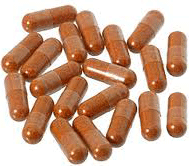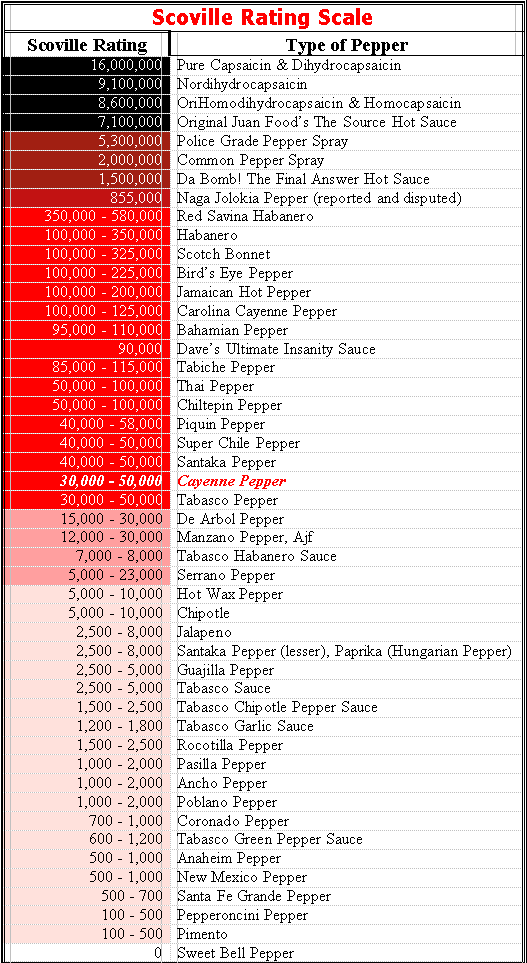
Did You Know There are Many Different Heat Classifications of Cayenne and Other Peppers?Scoville Rating Scale in Relation to Cayenne Pepper
Cayenne pepper is hot, really hot. If you’ve ever sprinkled it on a favorite Asian or Mexican dish, or if you’ve added it to your daily health regime, you know that. In order to give as much info as possible in this cayenne pepper website, I’d like to go over the Scoville Rating Scale and cayenne’s place in it and its importance. Cayenne pepper (or capsicum as it’s sometimes referred to as) is rated typically anywhere from 30,000 to 190,000 Scoville Heat Units (SHU) on the Scoville Rating Scale. In order to make sense of that rating system, let’s discuss it now. SideBar: (Quickly, if you want to start taking cayenne, start with 30,000 to 50,000 SHU cayenne pepper powder. You need to build up a tolerance for hotter cayenne so start small! Trust me on this.) The Scoville Rating Scale was devised by American chemist Wilbur Scoville in 1912. The Scoville scale measures the hotness or calidity of the chili pepper as determined by the amount of capsaicin in the pepper or sauce. The problem with the Scoville Rating Scale, or the Scoville Organoleptic Test as it’s sometimes called, is that it’s based on sensory perception and human subjectivity. A more accurate measurement of the heat of hot peppers and cayenne pepper is The Gillett Method, which is high-pressure liquid chromatography. This method measures the level of capsaicin and is more accurate. That said, the Scoville Rating Scale is fine for everyone who is not a scientist. Let’s Talk About CapsaicinCapsaicin is a chemical compound that stimulates the chemoreceptor nerve endings in the skin and in your mucous membranes. Capsaicin and other related compounds are called capsaicinoids and are produced as a secondary metabolite by chili peppers. So, in other words, it’s the capsaicin that makes cayenne pepper hot to the taste, and it's the capsaicin that
causes your mucus membranes to react so strongly. By the way, secondary metabolites are organic compounds not directly involved in the normal development, reproduction or growth of organisms, which organisms can include plants as well as animals. In the case of cayenne pepper, scientists believe the capsaicin developed as an evolutionary defense mechanism to discourage animals from eating it. That’s debatable, however. Okay Dude, So Just How Hot Is Cayenne Pepper on The Scoville Rating Scale?The most common way to evaluate a pepper’s pungency is a simple taste test. However, that’s not always wise, is it?! Below is a graphic that details the various ratings. Before you read through it, however, let me give some basic info on the chart. The chart in Scoville Heat Units below rates chiles, peppers, and sauces, with 0 being the mildest. The chart should be self-explanatory, however. That said, here’s how to read the chart:
As you will see on the Scoville scale graphic below, a sweet green pepper, which contains no capsaicin, has a Scoville rating of zero while the hottest chiles have a rating of 300,000 or more. This means that a chili’s extract, like a habanero would have to be diluted 300,000-fold before the capsaicin present is undetectable as in a green pepper. So, now that you know how to read the Scoville Heat Unit scale, here’s the graphic. Notice cayenne pepper is in the 30,000 to 50,000 range. However, that is average. The African birdseye cayene version (Capsicum fastigiatum) can come in at 90,000 to 160,000! Even the Capsicum annum version of cayenne can come in at 90,000 SHUs or above. Believe me, that is very, very hot. The health benefits I've been able to glean from cayenne have come with the plain 30,000 to 50,000 Capsicum annum American version.
In conclusion, as you can see, the Scoville scale is quite helpful in ranking the various peppers and sauces' heat units. Cayenne is really hot but it's not as bad as some peppers, believe me! Of course, there are different grades of cayenne pepper exceeding 125,000 to 190,000 SHU cayenne and beyond. The 30,000 to 50,000 SHU classification here is the general, average heat of cayenne pepper powder. Lastly, if you're interested in supplementing or experimenting with cayenne, you can get more information about buying good quality cayenne at within this article within this site. Or you can view a full product price list here. I hope this information is useful to you. |
|
2007-2024 Copyright © www.CayennePepper.info. All Rights Reserved.

